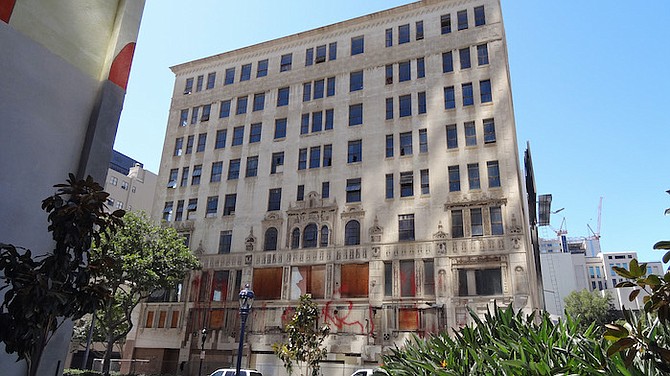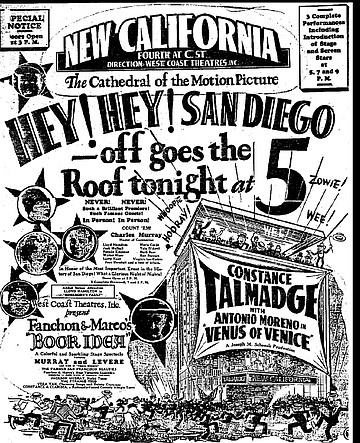 Facebook
Facebook
 X
X
 Instagram
Instagram
 TikTok
TikTok
 Youtube
Youtube

The crumbling and leaky California Theatre building, at 1122 Fourth Avenue (at C St.), built in 1927 at a cost of $340,000, has sat vacant since 1990. SOHO (Save Our Heritage Organisation) is fighting to preserve the historic property. But property owner/venture capital firm Sloan Capital Partners, LLC, of Beverly Hills, wants the structure removed to allow construction of a 40-story, 282-unit residential building.
Brad Richter, assistant vice president for planning at Civic San Diego, said, “There is an application for a residential tower with ground-floor retail, which proposes to demolish the California Theatre building.” The applicant declares the project will “promote social, civic and economic vitality along a blighted area of the C Street corridor.”

The Spanish Colonial Revival building, designed by John Paxton Perrine, was added to the list of San Diego's Register of Designated Historical Resources in 1990. The resolution described “the area specifically designated being the exterior of the building, and the lobby and interior of the theater.”
“Because the theater building has been determined to have potential state and national historical significance,” Richter said, “a supplemental environmental impact report is required, which is under preparation. The draft [report] is required to have a 45-day public review period, after which the final [report] is prepared before any public hearings.”
Bruce Coons, executive director of SOHO, said the building can't be demolished due to its local historic designation. The Downtown Community Plan requires a “mitigation measure” if a historical resource would be demolished. That measure, agreed to by the applicant, requires a document program to include “photo documentation and measured drawings” to the Historical Resources Board for approval.
Cyrus Sanandaji, principal with Sloan Capital, said that “our proposed revitalization program is the one and only financially feasible plan for this property — both from a development standpoint and from a community benefits standpoint.” Sanandaji added: “There is significant downtown interest and support for demolishing this blighted site. The Downtown San Diego Partnership, the Greater San Diego Chamber of Commerce, and many owners within a two-block area of the project and along the C Street corridor have indicated strong support for the proposed project.”
Coons said the site is not zoned for residential use. Yet, there are 28 loft apartments above the Ross store, right across Fourth Avenue. Also, the “site development permit findings,” prepared by attorney Marie Burke Lia in 2014, assert that the Downtown Community Plan allows this neighborhood to have mixed-use (residential and non-residential) projects that “contain active ground floor uses.”
Another group wants California Theatre saved from the wrecking ball. An online petition was launched nine months ago on change.org by Dawn N. Griffin, CEO of Davenports Supper Club & VIP Cigar Lounge, LLC. It's received 1341 signatures, with a goal of 1500.
In explaining her opposition, Griffin said, “The petition is to give the people interested a voice, and show the government factors we prefer an arts venue to another faceless glass box.” Griffin also negotiated a while back with Sloan Capital to buy the property.
“When my agent and their attorney had almost reached an acceptable agreement, their rep stepped in and placed ridiculous conditions on it nobody with common sense would agree to,” said Griffin. The asking price was $11.5 million, but Griffin's group offered $9.5 million. Negotiations ended with no sale.
Mayor Kevin Faulconer declined to comment. “The mayor’s office doesn’t typically comment on private projects going through the Development Services process,” emailed Craig Gustafson, director of media relations.

Third district councilmember Todd Gloria said: “It is always preferable to restore an historic structure when feasible. It wouldn't be appropriate to comment on a hypothetical as each project has to be considered on its merits, and there is a possibility that the council may be asked to weigh in on the matter in an appeal hearing.”
Going forward, said Richter, “the project and amendments will be considered at future undetermined meetings before the downtown community planning council, the CivicSD board, the Historical Resources Board, the planning commission, with the final decision by the city council.” Regarding those procedures, Sanandaji stated: “We are working with an experienced local consultant to help navigate the process.”
A 1990 report, "The California Theatre - An Architectural Appraisal,” by Thomas R. Vreeland FAIA, did not speak well of the theater's design. Vreeland wrote in part: “The opening of the California Theatre in 1927 was not an architectural event. A comparison with the 1912 Spreckels Theatre only a few blocks away quickly establishes the California as the inferior. The California Theatre is the work of a minor theater architect, and even as such, is not his best work. It is architecturally maladroit.”


The crumbling and leaky California Theatre building, at 1122 Fourth Avenue (at C St.), built in 1927 at a cost of $340,000, has sat vacant since 1990. SOHO (Save Our Heritage Organisation) is fighting to preserve the historic property. But property owner/venture capital firm Sloan Capital Partners, LLC, of Beverly Hills, wants the structure removed to allow construction of a 40-story, 282-unit residential building.
Brad Richter, assistant vice president for planning at Civic San Diego, said, “There is an application for a residential tower with ground-floor retail, which proposes to demolish the California Theatre building.” The applicant declares the project will “promote social, civic and economic vitality along a blighted area of the C Street corridor.”

The Spanish Colonial Revival building, designed by John Paxton Perrine, was added to the list of San Diego's Register of Designated Historical Resources in 1990. The resolution described “the area specifically designated being the exterior of the building, and the lobby and interior of the theater.”
“Because the theater building has been determined to have potential state and national historical significance,” Richter said, “a supplemental environmental impact report is required, which is under preparation. The draft [report] is required to have a 45-day public review period, after which the final [report] is prepared before any public hearings.”
Bruce Coons, executive director of SOHO, said the building can't be demolished due to its local historic designation. The Downtown Community Plan requires a “mitigation measure” if a historical resource would be demolished. That measure, agreed to by the applicant, requires a document program to include “photo documentation and measured drawings” to the Historical Resources Board for approval.
Cyrus Sanandaji, principal with Sloan Capital, said that “our proposed revitalization program is the one and only financially feasible plan for this property — both from a development standpoint and from a community benefits standpoint.” Sanandaji added: “There is significant downtown interest and support for demolishing this blighted site. The Downtown San Diego Partnership, the Greater San Diego Chamber of Commerce, and many owners within a two-block area of the project and along the C Street corridor have indicated strong support for the proposed project.”
Coons said the site is not zoned for residential use. Yet, there are 28 loft apartments above the Ross store, right across Fourth Avenue. Also, the “site development permit findings,” prepared by attorney Marie Burke Lia in 2014, assert that the Downtown Community Plan allows this neighborhood to have mixed-use (residential and non-residential) projects that “contain active ground floor uses.”
Another group wants California Theatre saved from the wrecking ball. An online petition was launched nine months ago on change.org by Dawn N. Griffin, CEO of Davenports Supper Club & VIP Cigar Lounge, LLC. It's received 1341 signatures, with a goal of 1500.
In explaining her opposition, Griffin said, “The petition is to give the people interested a voice, and show the government factors we prefer an arts venue to another faceless glass box.” Griffin also negotiated a while back with Sloan Capital to buy the property.
“When my agent and their attorney had almost reached an acceptable agreement, their rep stepped in and placed ridiculous conditions on it nobody with common sense would agree to,” said Griffin. The asking price was $11.5 million, but Griffin's group offered $9.5 million. Negotiations ended with no sale.
Mayor Kevin Faulconer declined to comment. “The mayor’s office doesn’t typically comment on private projects going through the Development Services process,” emailed Craig Gustafson, director of media relations.

Third district councilmember Todd Gloria said: “It is always preferable to restore an historic structure when feasible. It wouldn't be appropriate to comment on a hypothetical as each project has to be considered on its merits, and there is a possibility that the council may be asked to weigh in on the matter in an appeal hearing.”
Going forward, said Richter, “the project and amendments will be considered at future undetermined meetings before the downtown community planning council, the CivicSD board, the Historical Resources Board, the planning commission, with the final decision by the city council.” Regarding those procedures, Sanandaji stated: “We are working with an experienced local consultant to help navigate the process.”
A 1990 report, "The California Theatre - An Architectural Appraisal,” by Thomas R. Vreeland FAIA, did not speak well of the theater's design. Vreeland wrote in part: “The opening of the California Theatre in 1927 was not an architectural event. A comparison with the 1912 Spreckels Theatre only a few blocks away quickly establishes the California as the inferior. The California Theatre is the work of a minor theater architect, and even as such, is not his best work. It is architecturally maladroit.”